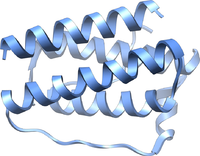
Photo from wikipedia
(1) Background: For the storage of human milk (HM), freezing, thawing, and/or pasteurization are routinely used in neonatal intensive care units. We aimed to analyze the effects of different HM… Click to show full abstract
(1) Background: For the storage of human milk (HM), freezing, thawing, and/or pasteurization are routinely used in neonatal intensive care units. We aimed to analyze the effects of different HM processing types on the nutritional contents in HM, adipose tissue, and the neuroprotection markers leptin and adiponectin. (2) Methods: HM samples from 136 mothers of preterm and term infants (gestational age 23 + 0 to 41 + 6) were collected and divided into four groups: (i) fresh HM, (ii) fresh pasteurized HM, (iii) thawed HM, and (iv) thawed pasteurized HM. The macronutrients were analyzed by mid-infrared transmission spectroscopy and the adiponectin and leptin were analyzed by high-sensitivity adiponectin and leptin enzyme-linked immunosorbent assay (ELISA). (3) Results: No significant differences were observed in the protein, carbohydrate, or fat concentrations between the HM processing types. The leptin levels were significantly lower after pasteurization in comparison to HM without pasteurization (p < 0.001). The protein levels in extremely preterm HM were significantly lower compared to those in moderate/late preterm HM and term HM (p < 0.05). (4) Conclusions: HM processing had an impact on leptin concentrations but no effect on the protein level. These data support the use of unpasteurized human milk for preterm infants’ nutrition and normal brain development. The protein levels of the milk of mothers from preterm compared to full-term infants differed, underlining the importance of individualized target fortification.
Journal Title: Nutrients
Year Published: 2023
Link to full text (if available)
Share on Social Media: Sign Up to like & get
recommendations!